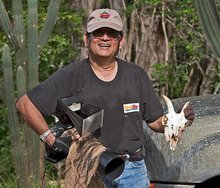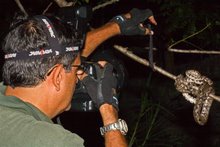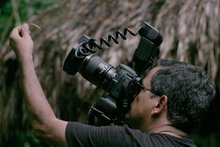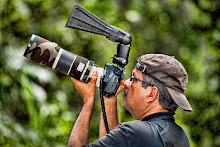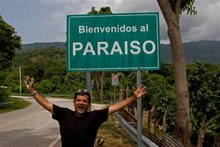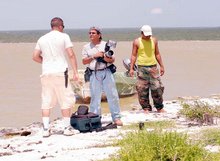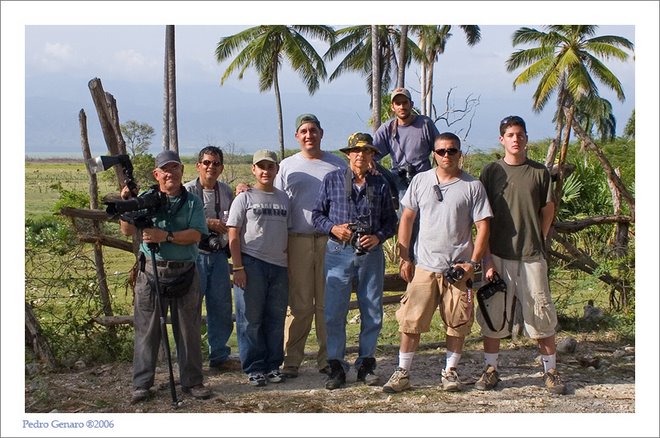Bisley, El Yunque (Caribbean) National Forest
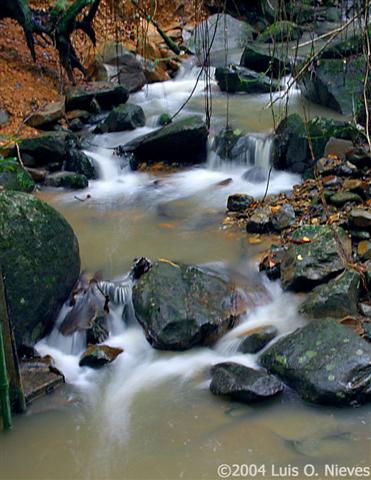
Bisley #3 Stream
Monday, April 9, 2007
Sometimes this is what you get!
In many instances, people ask how we are able to take photos so close to the different organisms we photograph. You could use "blinds" to hide, use camouflage and walk slowly, just get a lucky break, or other methods. But, sometimes you'll get what you deserve for taking risks while trying to capture "the image". For example, I have been stung by scorpions, stung by a swarm of bees, wasps and even almost had my head shaved by the claws of a female Accipiter striatus (Halcón de Sierra; Sharp-shinned Hawk).
During this photo session, after taking approximately 65 photos, ironically on the last photo and for no apparent reason, the bees attacked. Unluckily for me, 14 bees (that was the count of stings on my face) got inside the face mask I was wearing and stung me. The only thing I could do was walk away from the nest as calm as I could. After looking for any reason for the attack, we agreed that they were probably provoked by the dark camouflage jacket I was wearing.
The photo that follows shows how close I was to the beehive and was taken right when the attack started. The photographer (Arq. José G. Baralt), even though he was wearing a protective mask he had to rush out of the area to avoid being also stung.
In another case, to photograph this Pandion haliaetus (Aguila Pescadora; Osprey) at the Piñones State Forest,
To take this photo of a Chordeiles gundlachii (Querequequé; Antillean Nighthawk) that was nesting at the El Tuque area in Ponce, Puerto Rico,
I had to crawl about 150 feet!!! (Photo Below)
Friday, April 6, 2007
Are you into butterflies?
Anartia jatrophae - very common on mangrove and wetland areas.
Archaeoprepona demophoon ramosorum - these guys feed on tree sap.
Archaeoprepona demophoon ramosorum - these guys feed on tree sap.
Some of my "stinging foes".
Would you like to find these guys while walking at night inside a forest... it is better than the "Chupacabras"? ¡Ja! Well this comes with the territory; it is either this or just passing by a Urera baccifera or Ortiga Brava in your face.
Polistes americana
Tityus obtusus
Puerto Rican Screech-Owl
One night after searching for Eleutherodactylus populations at the El Yunque National Forest (formely known as Caribbean National Forest), while driving down on PR-191, this guy was perched on the left side of the road. It is the endemic Puerto Rican Screech-Owl (Megascops nudipes). This is a nocturnal species very common in forested or wooded areas.
Coquí Guajón
This is Eleutherodactylus cooki, the second largest species in Puerto Rico and locally known as Guajón or Coquí Guajón. It is considered an endangered species because of its habitat requirements and its extremely limited geographical distribution. This species is restricted to the southeast region of Puerto Rico and found in areas around the towns of San Lorenzo, Patillas, Maunabo, Humacao, Yabucoa, Juncos and Las Piedras. It is found at low and intermediate elevations (36 to 360 meters) in areas locally known as "Guajonales"; which are caves and/or large crevices formed by large basalt-granite boulder assemblages, usually adjacent to streams or flowing water. This species exhibits sexual dimorphism in vocalization, size and coloration. The males are yellowish from the tip of the lower mandible to the abdomen and flanks, while the females are white.
Top view

Male
Female
Coquí Llanero
In an island that is approximately just 100 x 35 miles, is was a surprise that last year a new species of Eleutherodactylus was discovered by Dr. Neftalí Ríos now at the University of Puerto Rico-Humacao. The new species was found in a small wetland area located at the abandoned U.S. Navy Base of Sabana Seca. Already the area is under pressure by development. This is the smallest Eleutherodactylus found in Puerto Rico, and is related to another species found at the island's mountain peaks, Eleutherodactylus gryllus. I won't include photos of the plant which serves as the habitat for obvious reasons.
Subscribe to:
Posts (Atom)















.JPG)
.JPG)

